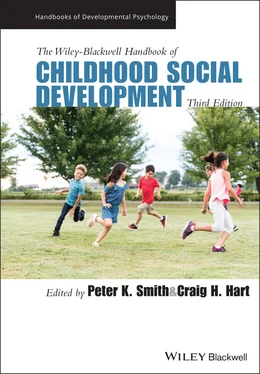The child originated from an environment in which the information in books was controlled by adults and was gradually supplied to children. However, anonymization as a result of telegraphy caused a development that would ultimately take away information from the authority of parents and the family. After the invention of telegraphy, this development was boosted by a continuous stream of inventions: the rotation press, camera, telephone, gramophone, film, radio, television (Postman, 1992, p. 76), culminating in what was not described by Postman, the launch of the internet. Mainly because these modern means of communication primarily use image language, the typical characteristic of childlikeness, illiteracy, loses its meaning. Knowing the alphabet is not a requirement for understanding images (Postman, 1992, p. 81). Television, for example, removes the dividing lines between children and adults to a large extent: “Supported by other electronic media which do not rely on the written word, television re‐creates communication conditions like those existing in the 14th and 15th centuries” (Postman, 1992, p. 82); “in the new media climate everything is available to everyone at the same time: electronic media cannot keep secrets …” and “without secrets the notion of the ‘child’ is void …” (Postman, 1992, p. 83).
Postman (1992) thoroughly demonstrated the disappearance of the child by presenting a large amount of (anecdotal) information on: the portrayal of young people as miniature adults in the media (p. 122); the disappearance of children’s songs (p. 123); the fading of the Disney view of the child (p. 125); the disappearance of children’s clothes, while adults have begun to wear clothes that were previously intended for children (p. 127 ff.); the disappearance of children’s games (p. 129), while top‐class sport has become normal to children (p. 129); and the decline of good manners (p. 132). All this together points to the decline of the notion of the “child,” said Postman, “and accordingly to a weakening of the nature of adulthood.” Postman’s book is concisely and powerfully summarized in the final sentence of the cover text: “The basic notion of this book – that our electronic information environment makes the ‘child’ disappear – can also be read as follows: an electronic information environment makes the adult disappear.”
It is important to realize that many books have been published in the 1970s that intend to free the child from the chains of its immaturity. An example of such books is that by Kuijer (1980). Other examples are Illich’s book, calling for a “deschooling” of society as it hinders children from participating in an adult society (Illich, 1973); Holt’s book, consistently pleading for freeing the child from the chains of a 300‐year‐old tradition of servitude (Holt, 1976); and Farson’s book, interpreting the rights of the child very literally and broadly, e.g., by demanding that children are given the right to vote, “because adults do not stand up for their interests and cannot vote on their behalf” (Farson, 1974, p. 179).
Interestingly, the period discussed by Postman in relation to the disappearance of childhood, the 1970s, also witnessed an unprecedented large global research effort, centering on undermining Piaget’s structural cognitive theory. In other words, the non‐inter‐convertible developmental stages, referred to as cognitive structures, were gradually replaced by continuous domain‐specific developmental processes. Neo‐Piagetian research from that time undermined the presumptions of the Rousseau‐Piaget tradition, which emphasized the in accessibility of childlike thinking, like never before. The fanaticism with which the origins of all kinds of childlike rationality were explored, caused many a researcher to end up as an “infancy expert” (Koops, 1990, 2004). This post neo‐Piagetian research, among other things, resulted in research on the Child’s Theory of Mind experimentally demonstrating how 2–3‐year‐old children already have a command of current lay psychology, based on a simple theory of desires and beliefs. Meanwhile, the search for the increasingly younger origins of generally human means of communication has not come to an end. Onishi and Baillargeon (2005), for example, demonstrated in an article in Science that 13‐month‐old babies basically have a command of generally human, ordinary communication principles (“beliefs” and “desires”). Two remarkable books summarize the surprising cognitive abilities of very young children (Wellman, 2014; Gopnik, 2009) Remarkably, cultural historical developments – the disappearance of traditional childhood – go hand in hand with the experimental empirical scientific search for (and finding of!) generally human and age‐independent means of communication. To put it briefly, developmental psychology moves with the tides of culture.
It will be clear that the modern Western child, construed in the 18th and 19th centuries – the Enlightened child – disappeared in the second half of the 20th century, marking the end of the historical process of infantilization. Traditional upbringing, which was based on this infantilization, was referred to as “ Bringing up by keeping small ” in a much‐quoted publication of Dasberg (1975). In essence, it boiled down to setting the child apart from the adult world and leading it step by step into that adult world by what was called upbringing. This style of upbringing has become outmoded: infantilization is behind us in the sense that borders between childhood and adulthood are less strict and vaguer than ever. Mainly through electronic media, today’s children have access to the adult world from the beginning, including the world of violence and sex, areas in which children on the basis of the then current pedagogy were not allowed access for two and a half centuries. Given the child’s access to the internet, it is an improbable atavism that American parents as late as in 2006 pressed charges against teachers who persisted in marking school work with red ink (Stearns, 2009). The parents feared that the feeble self‐esteem of their vulnerable children would be damaged.
Raising children will have to be re‐invented. We are assisted by a tremendous amount of sophisticated and splendid studies on child behavior and on that of their up‐bringers. However, I would like to point out that all this research will only prove advantageous if we know what our objective is with regard to children , and that is what we are in the dark about. Worse still, modern academic pedagogy is hardly occupied with it. People who like me, who are followers of Kant’s much maligned successor, the educationalist Johann Herbart (1776–1841), are convinced that pedagogy as a science cannot do without ethics at the one hand and (developmental) psychology on the other (Herbart, 1841). The first helps to formulate objectives, the latter offers the means to achieve them. An evolutionary view like Bjorklund’s (2007), however relevant, will not help out. Bjorklund explained why a lengthy human youth is necessary to be able to adapt to an ever‐changing culture. This view only makes clear why we should cherish an extended explorative childhood, but not if and how it should be oriented.
Let us return for a final time to the example set by Rousseau. His incredibly effective book on education was a book on a new ethical person in a Utopian society. This very context turned his book into such a success. Of course, we are not in a position of again starting a revolutionary vision on child development. Nevertheless, we could – as Rousseau did – develop a vision of an ideal society in the spirit of which we would like to raise our children. In doing so, I recommend a restoration of the Enlightenment principles of rationality and autonomous and critical thinking; high‐grade ethical principles forming the basis of a modern “ Contrat Social ” (Rousseau, 1762); and commitment to a democratic society in which freedom of speech and inter‐human respect are balanced. All this needs to be worked out. However, it is good and reassuring to know that we can fall back on enlightened classical literature. But only when we have clear normative notions will we be able to profit from the rich modern empirical developmental psychology, that is today at our disposal.
Читать дальше












